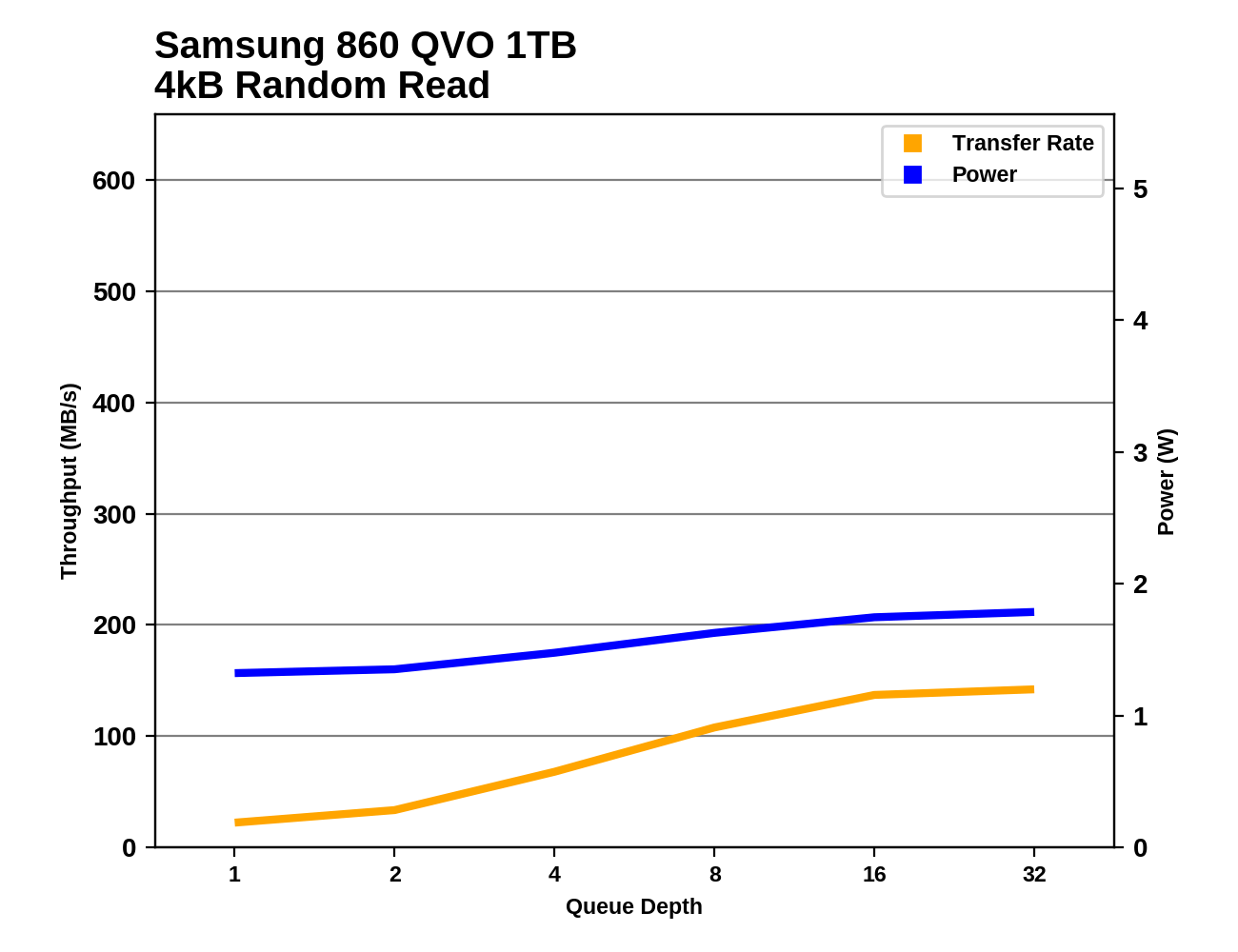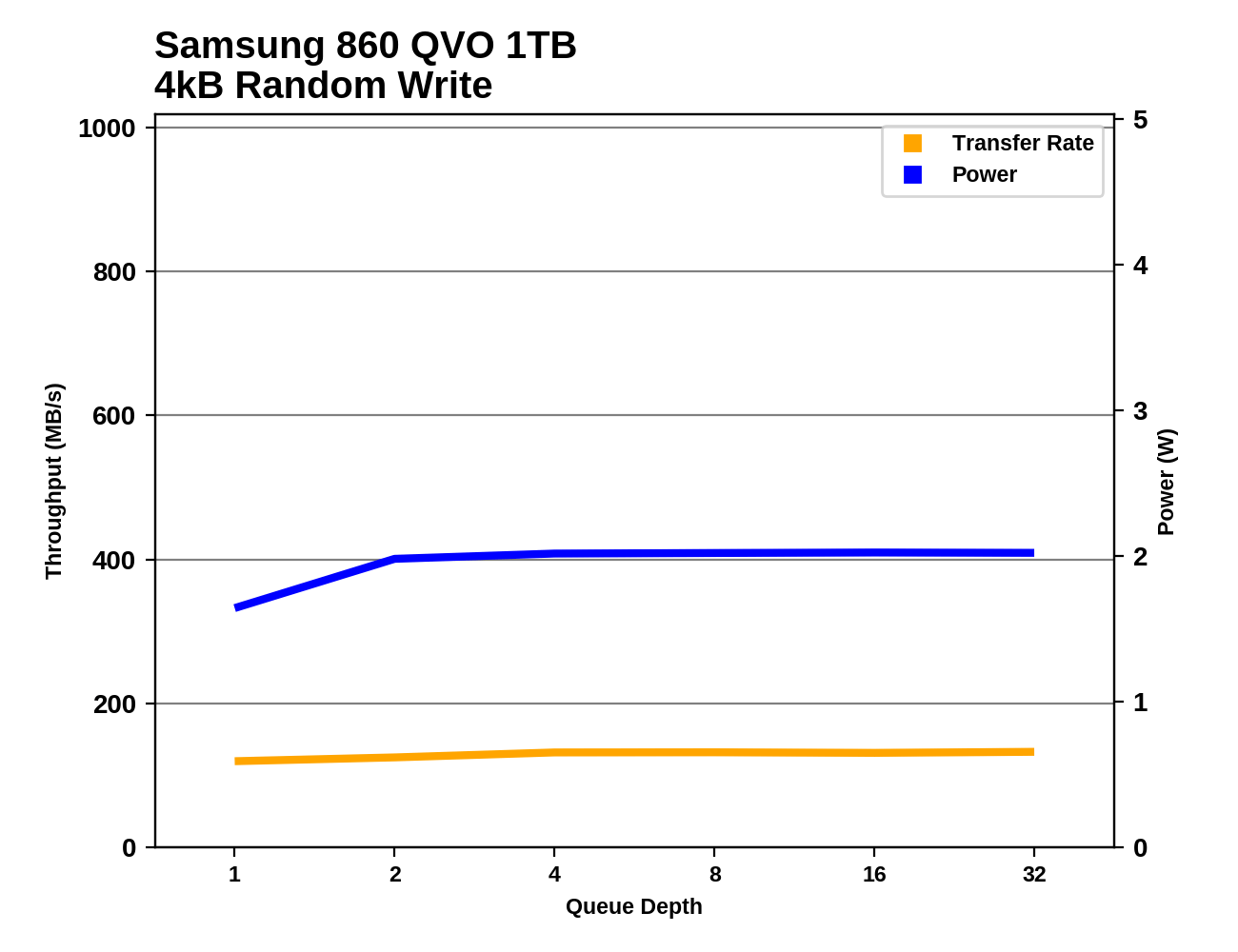The Samsung 860 QVO (1TB, 4TB) SSD Review: First Consumer SATA QLC
by Billy Tallis on November 27, 2018 11:20 AM ESTRandom Read Performance
Our first test of random read performance uses very short bursts of operations issued one at a time with no queuing. The drives are given enough idle time between bursts to yield an overall duty cycle of 20%, so thermal throttling is impossible. Each burst consists of a total of 32MB of 4kB random reads, from a 16GB span of the disk. The total data read is 1GB.

The burst random read performance of the Samsung 860 QVO is clearly lower than the 3D TLC competition, while the Intel/Micron QLC NVMe drives have no trouble competing against the field of mainstream SATA TLC drives. Even in the worst case of the smallest QVO being entirely full, read speeds are still vastly better than a hard drive.
Our sustained random read performance is similar to the random read test from our 2015 test suite: queue depths from 1 to 32 are tested, and the average performance and power efficiency across QD1, QD2 and QD4 are reported as the primary scores. Each queue depth is tested for one minute or 32GB of data transferred, whichever is shorter. After each queue depth is tested, the drive is given up to one minute to cool off so that the higher queue depths are unlikely to be affected by accumulated heat build-up. The individual read operations are again 4kB, and cover a 64GB span of the drive.

On the longer random read test, the Toshiba TR200 DRAMless TLC drive is no longer able to stay ahead of the 860 QVO, and even the Intel/Micron QLC drives fall behind most mainstream SATA drives (especially when full).
 |
|||||||||
| Power Efficiency in MB/s/W | Average Power in W | ||||||||
The power consumption of the 860 QVO during the random read test is only slightly higher than its TLC-based relatives, but that's plenty to push its efficiency scores into last place, given the poor performance.
 |
|||||||||
The queue depth scaling of the 860 QVO during random reads is fairly typical in shape, with improvements starting to taper off after QD16. However, the vertical scale is important: the QVO doesn't ever reach even half the performance of the best TLC-based SATA SSDs.
Looking at the 1TB 860 QVO's random read results compared to all the other SATA drives in the benchmark database, it is clear that the QVO isn't anywhere near the cutting edge for power efficiency or peak performance, but there are worse drives out there.
Random Write Performance
Our test of random write burst performance is structured similarly to the random read burst test, but each burst is only 4MB and the total test length is 128MB. The 4kB random write operations are distributed over a 16GB span of the drive, and the operations are issued one at a time with no queuing.

The SLC cache of the 860 QVO is very effective for the burst random write test, leaving it tied or slightly ahead of the 860 EVO.
As with the sustained random read test, our sustained 4kB random write test runs for up to one minute or 32GB per queue depth, covering a 64GB span of the drive and giving the drive up to 1 minute of idle time between queue depths to allow for write caches to be flushed and for the drive to cool down.

On the longer random write test, the larger SLC cache and greater parallelism of the 4TB 860 QVO helps it keep pace with other top SATA SSDs, but the 1TB QVO has to settle for being slightly faster than the DRAMless TLC drive.
 |
|||||||||
| Power Efficiency in MB/s/W | Average Power in W | ||||||||
The QVO is again a bit more power hungry than most of the TLC drives, which doesn't hurt the 4TB QVO's efficiency score much thanks to its good performance, but the 1TB QVO ends up tied for last place with the full-drive performance from the Intel/Micron QLC drives.
 |
|||||||||
The 1TB 860 QVO shows very little random write performance scaling with increasing queue depth, though power consumption does go up significantly from QD1 to QD2. The 4TB 860 QVO shows a much more typical scaling up to saturation at QD4, with a performance curve that is almost an exact match for the 4TB 860 EVO.
There are some TLC SATA SSDs that draw the same power to deliver half the random write performance of the 1TB 860 QVO, but in the grand scheme of things the 1TB QVO's results on this test are sub-par. The 4TB starts out in the same spot but ends up hitting the SATA performance wall without consuming too much power.












109 Comments
View All Comments
Impulses - Thursday, November 29, 2018 - link
Bleh, googling revealed that WAS on Amazon... It never triggered my price alerts, hrm, even tho it's definitely showing on Camelcamel's price history now, weird. Maybe I glossed over it entirely, oh well.The_Assimilator - Thursday, November 29, 2018 - link
https://www.pcgamer.com/crucials-2tb-mx500-ssd-is-...hojnikb - Tuesday, November 27, 2018 - link
@BillyCan you do a data retention test ? Like writing the drive with data (H2testw seems to be the pick of the bunch) and disconnecting it. I'm interested how data retention holds up over time.
JoeyJoJo123 - Tuesday, November 27, 2018 - link
Don't use SSDs for cold storage. Testing this is absurdly stupid and a waste of a reviewers time.Disconnect drive for 10 days: Replug it in and verify data's still all there. Yep.
Disconnect drive for 15 days: Replug it in and verify data's still all there. Yep.
Disconnect drive for 20 days: Replug it in and verify data's still all there. Yep.
(We're already at 45 days, or 1.5 months, and chances are the data's still all there, are you getting how and why this kind of testing is stupid?)
By the time you get to sufficiently long enough time periods to see some change in data you'd have wasted over a year trying to find a time period (within 5 days) where you know the drive will start losing data. This is just as absurd as asking reviewers to test NAND flash endurance by hammering the drive 24/7 for years until it dies. By the time it DOES die something better will have already arrived on the market. And disregarding all that, testing with a sample size of ONE is not indicative of any relevant performance characteristics for your ONE drive.
If you want to use cold storage backups, either use a mechanical hard drive, a tape drive, or invest in cloud storage and encrypt your data before uploading it.
Testing the cold storage capabilities of a sample size of ONE QLC SSD does nothing but prove that it's a less satisfactory use case for the technology than using a mechanical hard drive.
HollyDOL - Tuesday, November 27, 2018 - link
I _think_ you can find Google or Facebook statistics on their SSDs, error rate etc. in representative volumes. But ofc it is enterprise grade hardware.hojnikb - Wednesday, November 28, 2018 - link
Not for QLC.hojnikb - Wednesday, November 28, 2018 - link
You're not thinking very far. As QLC is very cheap, it will be used in likes of flash drives, SD cards and portable SSDs. With these, it's not expected for them to be powerred at all time and in the case of sd cards and flash drives, it's not likely controller would do any kind of data rewritting.So this is very much a relavant test, that might give us ideas on how it performs. And no, you don't have to wait a year to see something; data curruption can be presented a lot sooner if from of read error and slower read speed in general. A more extreme approach is to heat the drive, which accelarates the process.
eddieobscurant - Tuesday, November 27, 2018 - link
Horrible performance by samsung 64 layer qlc nand. Way slower than intel's/micron's . Especially the 4k random reads are slower than my first ssd 10 years ago, the intel x-25m.In order for samsung 860 qvo to make sense, it should be priced below 0.10$/gb
stargazera5 - Tuesday, November 27, 2018 - link
Great, now that we have QLC down, we can move on to PLC (5 bits per cell) and 1 drive write per week.CheapSushi - Wednesday, November 28, 2018 - link
And from the current trend, it still won't be much cheaper. =P